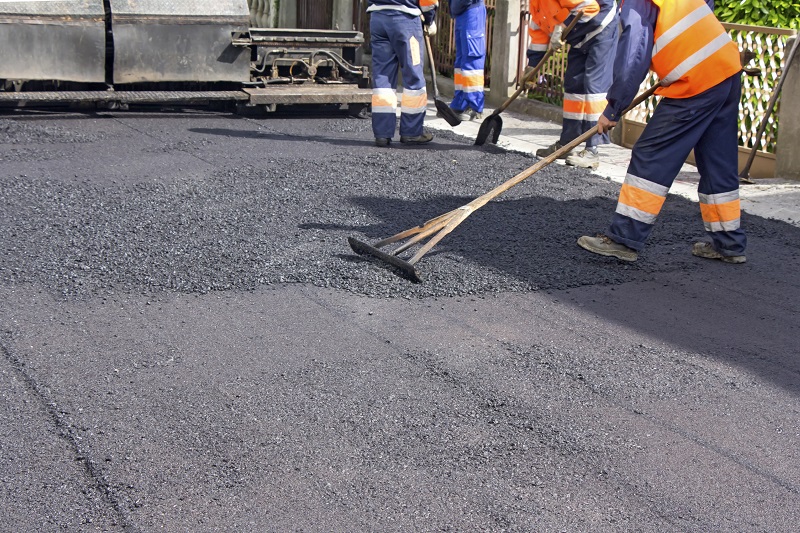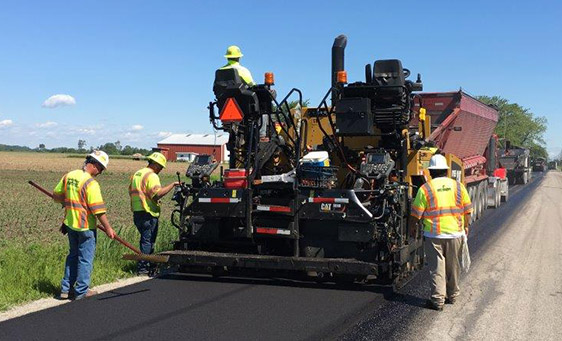Change Your Home's Landscape with Hot Mix Asphalt Paving Excellence
Wiki Article
Opening the Tricks of Warm Mix Asphalt Technology
Exploring the depths of hot mix asphalt innovation discovers a world where accurate formulas and careful processes merge to form our roadways and infrastructure. The combination of fillers, accumulations, and binders isn't merely a building job but a calculated orchestration of sturdiness and performance.Value of Warm Mix Asphalt
Warm Mix Asphalt plays an important function in contemporary infrastructure development because of its durability and cost-effectiveness. As the most frequently used paving product for roads, highways, and parking lots, Warm Mix Asphalt uses an array of advantages that contribute to its value in construction tasks. One essential benefit is its capacity to endure hefty traffic tons and rough weather, offering a resilient and trusted surface area for transport networks. Furthermore, Warm Mix Asphalt is economical in both preliminary construction and long-term maintenance, making it a recommended option for many framework projects.The longevity of Hot Mix Asphalt stems from its structure, which includes aggregates, binder, and filler materials that are thoroughly chosen and blended to meet specific efficiency requirements. This accurate mix leads to a flexible and strong pavement that can sustain frequent usage without significant wear and tear. Hot Mix Asphalt is 100% recyclable, additional boosting its sustainability and environmental advantages. In general, the importance of Hot Mix Asphalt in facilities advancement can not be understated, as it proceeds to be a foundation of contemporary building and construction practices.
Components of Asphalt Mixes
The composition of asphalt mixes consists of very carefully picked accumulations, binder, and filler products that are essential for accomplishing particular performance demands. Aggregates are the main element of asphalt blends, providing toughness and stability. These aggregates can be all-natural, such as crushed rock or crushed stone, or artificial, like recycled materials from old pavements. The binder, usually bitumen or asphalt cement, holds the aggregates together and supplies flexibility and longevity to the mix. The option of the binder is crucial as it straight influences the mix's performance in different climate conditions. Fillers, such as hydrated lime or Rose city cement, are used to enhance the mix's workability and aging resistance. Angled Parking.The mix and percentage of these components play a significant duty in identifying the top quality and efficiency of the asphalt mix. Designers carefully develop the mix to satisfy specific needs, taking into consideration variables like web traffic volume, environment problems, and sidewalk life-span. Correct choice and balancing of accumulations, binder, and fillers are essential for creating sturdy, long-lasting asphalt pavements.
Combining and Manufacturing Strategies

As soon as the aggregates are chosen, the binder, frequently asphalt concrete, is contributed to bind the products together. The binder's high quality and amount substantially impact the mix's resistance, strength, and adaptability to environmental variables. Furthermore, fillers like hydrated lime or Portland cement may be incorporated to improve particular qualities of the asphalt mix, such as its workability or moisture resistance.
During production, the accumulations and binder are heated, typically between 250-325 ° F(121-163 ° C ), to assist in blending and make sure proper layer of the accumulations. The mixing procedure should be extensive to attain a homogeneous mix that advertises the wanted performance qualities of the asphalt. Different techniques, such as batch mixing or drum blending, are utilized to accomplish consistent and premium asphalt blends for construction projects.
Factors Influencing Asphalt Efficiency
Factors influencing asphalt efficiency incorporate a range of variables that impact the toughness, longevity, and total high quality of asphalt sidewalks. One crucial element is the top quality of materials made use of in the asphalt mix.
Ecological conditions likewise affect asphalt performance. Temperature level variations, moisture infiltration, and traffic tons can all impact the structural stability of the pavement. Layout factors to consider, such as pavement thickness and drainage, are important in making sure the lasting performance of the asphalt pavement. By very carefully considering these aspects, designers and specialists can enhance asphalt efficiency and enhance the life span of sidewalks.
Sustainable Practices in Asphalt Modern Technology

Furthermore, the advancement of warm-mix asphalt (WMA) modern technologies has gotten grip in the last few years. WMA permits the production and placement of asphalt mixes at reduced temperature levels contrasted to traditional hot-mix asphalt, Get More Information causing decreased energy intake and greenhouse gas exhausts. Additionally, the usage of porous asphalt mixes can help minimize stormwater runoff concerns by allowing water to penetrate through the sidewalk and into the ground, advertising all-natural water filtering and charge procedures. By executing these lasting techniques, the asphalt market can contribute to building an extra eco-friendly and resilient framework network.
Verdict
In conclusion, hot mix asphalt modern technology plays an essential role in modern facilities development as a result of its sturdiness and cost-effectiveness. By meticulously balancing parts, using appropriate mixing methods, and taking into consideration various variables, designers can develop top quality asphalt mixes that endure rush hour loads and extreme weather. Embracing lasting techniques, such as utilizing recycled products and warm-mix innovations, better improves the ecological friendliness of asphalt innovation.
Blending and manufacturing strategies in warm mix asphalt modern technology include the accurate mix and processing of accumulations, binder, and fillers to produce a high-performance and sturdy asphalt mix.Elements affecting asphalt performance include a range of variables that affect the longevity, longevity, and total high quality of asphalt sidewalks. Sustainable methods in asphalt technology encompass different efforts Bonuses aimed at reducing the environmental influence of asphalt production and paving procedures. By integrating redeemed asphalt sidewalk (RAP) and recycled asphalt shingles (RAS) into brand-new asphalt mixes, the industry can substantially minimize the consumption of raw materials and power, while likewise reducing garbage dump waste.
WMA allows for the production and positioning of asphalt mixes at reduced temperatures contrasted to conventional hot-mix asphalt, resulting in reduced power consumption and greenhouse gas emissions.
Report this wiki page